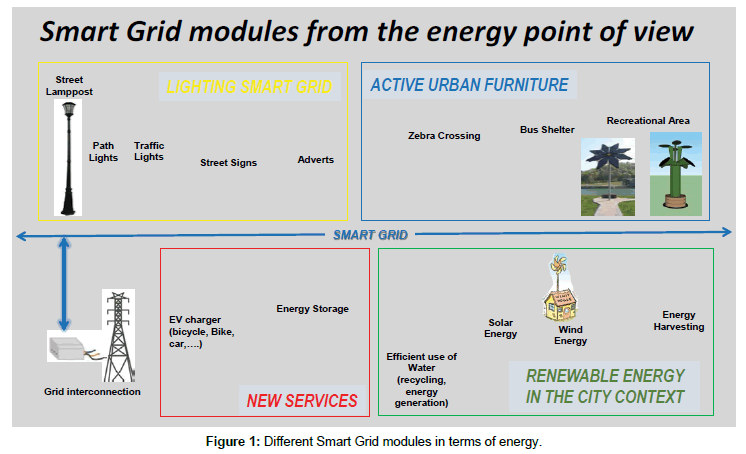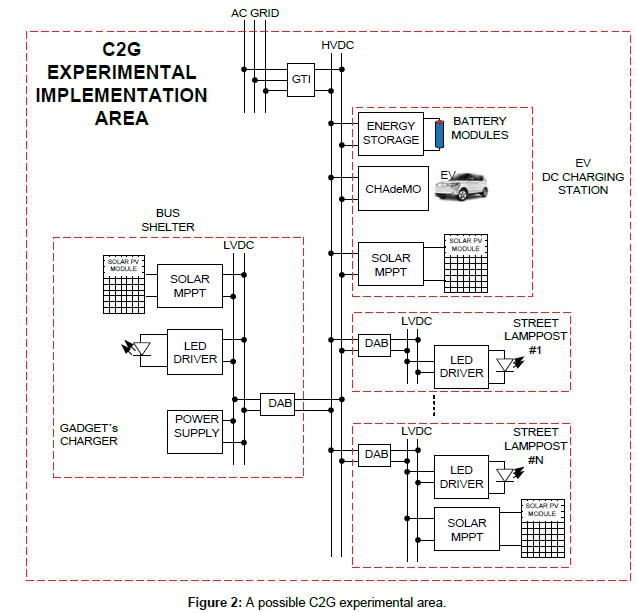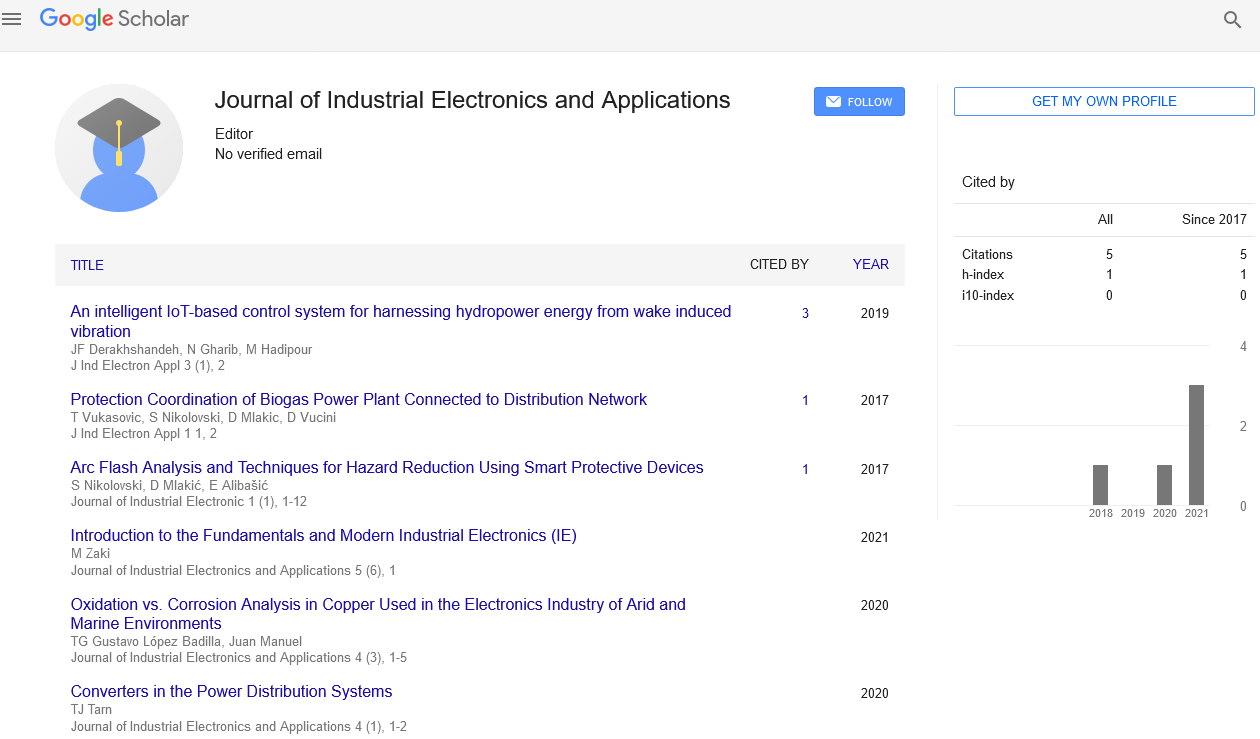Editorial, J Ind Electron Appl Vol: 1 Issue: 1
City to Grid (C2G): A Multidisciplinary Opportunity to Engineers Working on Industrial Electronics
Manuel Rico-Secades*
University of Oviedo-Gijon Industrial Engineering School, Gijon, Asturias, Spain
*Corresponding Author : Manuel Rico-Secades
University of Oviedo, Gijon Industrial Engineering School, Gijon, Asturias, ES-33204, Spain
Tel: +34- 625104726
E-mail: mrico@uniovi.es
Received: July 25, 2017 Accepted: July 25, 2017 Published: July 30, 2017
Citation: Rico-Secades M (2017) City to Grid (C2G): A Multidisciplinary Opportunity to Engineers Working on Industrial Electronics. J Ind Electron Appl 1:1.
Abstract
City to Grid (C2G): A Multidisciplinary Opportunity to Engineers Working on Industrial Electronics
A new journal comes to life. The Journal of Industrial Electronics and Applications is open to a wide variety of topics and research lines. This editorial is meant to outline a possible multidisciplinary trajectory which provides different research opportunities to engineers working on Industrial Electronics topics. Cities are seen today, from the electric energy point of view, as a set of individual power loads with an unpredictable global behavior (lighting, HVAC, domestic loads and more), but because of several emerging technologies (EV, renewable energies, IoT), the increasing environmental sensitivity and the proposal of new services to citizens, this view of the city is changing drastically. The coordination of power loads to operate as a large single load, the unstoppable introduction of renewable energies in urban environments and the need for energy storage motivated by the rise of EVs are possible due to the growth of IoT. This allows cleverly coordination of every element in the city and therefore its transformation into a great power load, a great energy farm or a large energy storage system (IoE). The coordination of many small elements permits the operation as large modules. Just to mention a few of the technologies involved we can find: lighting engineering, energy storage, EV charging stations, renewable energy generators, wireless communications, control strategies for DC energy distribution, active urban furniture, grid interconnection strategies and many more. The generic denomination of C2G has been used to encompass all these different technologies. Diverse concepts and new ideas about C2G serve as the guiding thread to propose a work trajectory to this new journal. Like the Spanish poet, Antonio Machado, said: "Traveler, there is no path. Paths are made by walking".
Keywords: Energy Storage; Renewable Energy; Electric Vehicle; Internet of Things; Internet of Energy; City to Grid; Smart Grid; Lighting Smart Grid; Kinetic Smart Grid
Abbreviations
LSG: Lighting Smart Grid; KSG: Kinetic Smart Grid; EV: Electric Vehicle; IoT: Internet of things; IoE: Internet of Energy; C2G: City to Grid; HVAC: Heating, ventilation and air conditioning; DHW: Domestic Hot Water; AUF: Active Urban Furniture; ICT: Information and Communication Technology; GTI: Grid Tie Inverter; DAB: Double- Active Bridge Converter; MPPT: Maximum Power Point Tracking
Introduction
The need to globally improve people’s life standards together with environmental awareness, Open Data and the emergence of new services to the citizens, make of our cities a field of research and development of new concepts and technologies which are pushing to change from the traditional concept of city to a new one denoted as Smart City.
Some years ago, the term Smart City was considered to be part of the subjects related to the Information and Communication Technology (ICT): Open Data, new services to the citizens, Internet of Things (IoT) [1-3], but technology is changing these original concepts including elements, modules and services linked with electrical energy (Figure 1).
From the point of view of the electrical energy, the city has traditionally been seen as a distributed power load composed of a large variety of individual energy consumption points totally disconnected and quite unpredictable. Among the main electrical charges of a city, lighting plays an important role, both in the streets and inside buildings. Lighting represents an extremely distributed power load, but globally it represents a very important percentage of the total consumption [4]. If the city could coordinate and control its lighting in a unified way, it could be considered a great consumer and benefit from strategies such as reduction of consumption on demand of the electric company for example [5].
The incorporation of LED lighting technology in this field has yield a considerable power reduction of the electrical consumption as well as great capacity of regulation and personalization. In addition, the appearance of wireless technologies (IoT) has given rise to the socalled Lighting Smart Grids (LSG) [6-12].
LSG studies are usually related to DC energy distribution (both low and high voltage). The LED lamps are supplied by means of LED drivers that benefit from the inclusion of IoT technologies [13].
Heating, Ventilation and Air Conditioning (HVDC) and Domestic Hot Water (DHW) are other considerable loads in the urban context. These well-known elements generally make use of oil & gas energy generation systems. However, the increasing environmental awareness is currently pushing towards the elimination of this pollutant energies and making way to modern renewable ones [14-16]: Small solar power installations [17], micro-generation wind [18] and hydraulic micro-generation in rivers or close to the shore (also known as Kinetic Smart Grid (KSG) [19].
Therefore, cities are meant to give up their traditional role and become a distributed renewable energy generation system. Through the coordination of all these micro-generation systems, modern cities will be able to operate as large Renewable Energy Farms. New concepts and ideas are about to be developed by Power Electronics researchers regarding energy distribution strategies in DC (both in low and high voltage) [20] and energy injection to the AC grid [21-24].
However, without hesitation, the great revolution we are beginning to live is related to the Electric Vehicle (EV) [25]. It will change the global energy paradigm as well as having a particular impact upon urban environments [26,27]. Private EV charging points in garages and EV charging stations in urban context shall necessarily require Energy Storage Systems which will introduce new elements into the urban environment [28]. A possible experimental setup that includes different aforementioned elements is depicted in Figure 2. The EV DC charging stations will provide new opportunities to interconnect all the electrical elements in the city in an organized way.
From the stand point of electric power, the city not only will behave as a distributed Power Load or a distributed Power Generation System but also will add the possibility to work as a distributed Energy Storage System, where EVs itself and EV charging stations will play a transcendental role in the future landscape of our cities [29].
The coordinated management of all these elements pushes the concept of IoT towards the more specific concept of IoE [30,31]. Some of the specific R&D lines in this field are linked with the coordinated management of power loads, renewable generation systems, energy storage systems and stable power transfer between multiple buses (Master-Slave and Droop Control) [32]. Besides, as the traditional AC grid will continue to be the basic city skeleton in terms of energy, the search for better circuits to interface with AC mains will also be an interesting field of research [33-35].
Among others, research in bidirectional power converters and its control strategies are extremely actives R&D lines [36-38] regarding the above mentioned issues.
One of the things that will happen in the near future is that, the conventional elements of urban furniture, today designed to meet aesthetic conditions and provide basic functional services to citizens [39], will evolve towards active elements (Active Urban Furniture- AUF) aiming to be the support of renewable generation systems, containing in their interior elements of energy storage and providing new citizen services (charging points for gadgets [40] or electric bicycles for example) [41].
All this cocktail of technologies open the door to engineers working on the field of Industrial Electronics to a new multidisciplinary world of technology concepts and ideas that we have called in this editorial City to Grid (C2G). The city of the future in terms of energy [42].
Acknowledgements
I would firstly like to thank the Journal Coordinator of the Journal of Industrial Electronics and Applications and its Editorial Board for the great honor of writing this kick-off editorial.
I also would like to cite my colleagues from the University of Oviedo. Firstly, the members of the CE3I2 Research Group, in particular Dr. Emilio Lopez- Corominas, Dr. Antonio Javier Calleja-Rodriguez, Dr. Javier Ribas-Bueno and Dr. Pablo Quintana-Barcia for their help and advice in preparing this editorial. I also would like to appreciate the collaboration of the Dr. Eduardo Alvarez- Alvarez from the Hydraulic Engineering Research Group and, finally, I would like to mention the engineering student Ms. Sara Rico-Rivero for the aid provided in the writing and grammatical correction of this document.
References
- Kayastha N, Niyato D, Hossain E, Han Z (2014) Smart grid sensor data collection, communication, and networking: A tutorial. Wirel Commun Mob Comput 14: 1055-1087.
- Tuballa ML, Abundo ML (2016) A review of the development of Smart Grid technologies. Renew Sustainable Energy Rev 59: 710-725.
- Curiale M (2014) Smart grids to smart city. Smart Grid Conference, Saudi Arabia.
- Gil-de-Castro A, Moreno-Munoz A, Larsson A, de la Rosa JJD, Bollen MHJ (2013) LED street lighting: A power quality comparison among street light technologies. Light Res Technol 45: 710-728.
- Siano P (2014) Demand response and smart grids-A survey Renew. Sustain Energy Rev 30: 461-478.
- Jaureguizar M, Rico-Secades M, Corominas EL, García-Llera D, Calleja AJ (2013) International Conference on New Concepts in Smart Cities: Fostering Public and Private Alliances, Spain
- Martín-Arias M, Huerta-Medina N, Rico-Secades M (2013) Using wireless technologies in Lighting Smart Grids in Conference and Exhibition-International Conference on New Concepts in Smart Cities: Fostering Public and Private Alliances, SmartMILE.
- Garcia-Llera D, Rodriguez C, Javier A, Huerta-Medina N, Rico-Secades M, et al. (2016) Optimizing LED lamps design for street lighting with staggered arrangement allowing energy saving strategies in a Lighting Smart Grid context. 51st Annual Meet IAS.
- Castro M, Jara AJ, Skarmeta AFG (2013) Smart lighting solutions for smart cities. 27th International Conference on Advanced Information Networking and Applications.
- Srivatsa DK, Preethi B, Parinitha R, Sumana G, Kumar A (2013) Smart Street Lights. Texas Instruments India Educators Conference.
- Suzdalenko A, Milashevski I, Galkin I (2012) Comparative study of smart lighting grids with LEDs operated with concentrated, localized or distributed control. 21st International Symposium on Power Electronics, Electrical Drives, Automation and Motion.
- Lee CK, Li S, Hui SY (2011) A design methodology for smart LED lighting systems powered by weakly regulated renewable power grids. IEEE Trans Smart Grid 2: 548-554.
- Thomas BA (2010) Edison revisited: Impact of DC distribution on the cost of LED lighting and distributed generation. Conference Proceedings-IEEE Applied Power Electronics Conference and Exposition, USA
- Maleki A, Khajeh MG, Ameri M (2016) Optimal sizing of a grid independent hybrid renewable energy system incorporating resource uncertainty, and load uncertainty. Int J Electr Power Energy Syst 83: 514-524.
- Yumrutaş R, Unsal M (2012) Energy analysis and modeling of a solar assisted house heating system with a heat pump and an underground energy storage tank. Sol Energy 86: 983-993.
- Alvarez-Fernandez M, Elias-Viejo P, Marcos-Casado P (2017) Ecoshelter powered by 100% renewable solar energy. Work J 1: 1-22.
- Huld T, Dunlop ED (2017) Photovoltaic Geographical Information System-Interactive Maps.
- Carrasco JM, Franquelo LG, Bialasiewicz JT, Member S, Galván E, et al. (2006) Power-Electronic Systems for the Grid Integration of Renewable Energy Sources : A Survey. IEEE Trans Ind Electron 53: 1002-1016.
- Alvarez EA, Rico-Secades M, Suárez DF, Gutiérrez-Trashorras AJ, Fernández-Francos J (2016) Obtaining energy from tidal microturbines: A practical example in the Nalón River. Appl Energy 183: 100-112.
- Elsayed AT, Mohamed AA, Mohammed OA (2014) DC microgrids and distribution systems: An overview. Electr Pow Syst Res 119: 407-417.
- Guerrero JM, Vasquez JC, Matas J, De Vicu LG, Castilla M (2010) Hierarchical control of droop-controlled AC and DC microgrids-A general approach toward standardization. IEEE Trans Ind Electron 58: 158-172.
- Lu X, Guerrero JM, Sun K, Vasquez JC (2013) An improved droop control method for dc microgrids based on low bandwidth communication with dc bus voltage restoration and enhanced current sharing accuracy. IEEE Trans Power Electron 29: 1800-1812
- Vasquez JC, Guerrero JM, Luna A, Rodr P, Teodorescu R (2009) Adaptive droop control applied to voltage-source inverters operating in grid-connected and islanded modes. IEEE Trans Ind Electron 56: 4088-4096.
- Wu D, Tang F, Vasquez JC, Guerrero JM (2014) Control and analysis of droop and reverse droop controllers for distributed generations. IEEE 11th International Multi-Conference on Systems, Signals and Devices.
- Wu Q, Nielsen AH, Stergaard J, Cha ST, Ding Y (2011) Impact study of electric vehicle (EV) integration on medium voltage (MV) grids. IEEE PES Innovative Smart Grid Technologies Conference, Europe.
- Grenier A, Page S (2012) The impact of electrified transport on local grid infrastructure: A comparison between electric cars and light rail. Energ Policy 49: 355-364.
- Trigg T, Telleen P, Boyd R, Cuenot F (2013) Global EV Outlook: Understanding the Electric Vehicle Landscape to 2020. IEA 1-41.
- Aneke M, Wang M (2016) Energy storage technologies and real life applications-A state of the art review. Appl Energy 179: 350-377.
- Luo C, Huang YF, Gupta V (2015) Placement of EV charging stations-balancing benefits among multiple entities. IEEE Trans Smart Grid 8: 759-768.
- Bui N, Castellani AP, Casari P, Zorzi M (2012) The internet of energy: A web-enabled smart grid system. IEEE Netw 26.
- Shrouf F, Miragliotta G (2015) Energy management based on Internet of Things: Practices and framework for adoption in production management. J Clean Prod 100: 235-246.
- Rico-Secades M, Calleja A, Llera DG, Corominas EL, Medina NH, et al. (2016) Cosine Phase Droop Control (CPDC) for the Dual-Active Bridge in lighting smart grids applications. IEEE International Conference on Industrial Technology.
- Quintana PJ, Garcia J, Cardesin J, Corominas EL (2015) A unified switching strategy in bidirectional grid interface DCM flyback stages for public street lighting systems with microgeneration capability. 51st Annual Meeting IAS.
- Garcia J, Dalla-Costa MA, Kirsten A, Gacio D, Quintana P (2012) Study of a flyback-based stage as grid interface topology for micro-generation applications. 15th International Power Electronics Motion Control Conference Expo.
- De Melo MF, Vizzotto WD, Quintana PJ, Kirsten AL, Dalla Costa MA, et al. (2015) Bidirectional grid-tie flyback converter applied to distributed power generation and street lighting integrated system. IEEE Trans Ind Appl 51: 6.
- Moonem M, Pechacek C, Hernandez C, Krishnaswami H (2015) Analysis of a Multilevel Dual Active Bridge (ML-DAB) DC-DC Converter Using Symmetric Modulation. Electronics 4: 239-260.
- Mahlia TMI, Saktisahdan TJ, Jannifar A, Hasan MH, Matseelar HSC (2014) A review of available methods and development on energy storage; Technology update. Renew Sustain Energy Rev 33: 532-545.
- Chen W, Wang G, Zhu X (2013) A family of bidirectional DC/DC converters suitable for asymmetrical power flow requirement. IEEE Energy Convers Congr Expo.
- Bulduk B (2012) An Analysis of the Use of Urban Furniture in City Advertising in Terms of Aesthetic/Visual Appreciation Training: City Design. Procedia-Soc Behav Sci 46: 3279-3283.
- Gutierrez-Grana D, Crespo-Iglesias M, Fidalgo-Ramos D (2015) Educational Street Charge Point with Smart Lighting based on LED’s powered by a PV Solar Module. WRJ.
- Kammen DM, Sunter DA City-integrated renewable energy for urban sustainability. Science 352: 922-928.
- Karnouskos S, Da Silva PG, Ilic D (2012) Energy services for the smart grid city. 6th IEEE International Conference.
 Spanish
Spanish  Chinese
Chinese  Russian
Russian  German
German  French
French  Japanese
Japanese  Portuguese
Portuguese  Hindi
Hindi 

